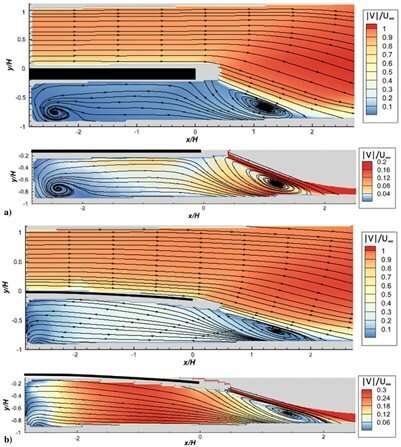New data set improves modeling of supersonic flows around a cantilever

Extreme pressures come with high-speed flight. The resulting aerodynamic forces can bring significant risk to deforming the components of the vehicle in motion—even to the point of aeroelastic deformation—when solids behave more like liquids. This can jeopardize stability or controllability of the entire vehicle.
University of Illinois Urbana-Champaign researchers in the Department of Aerospace Engineering, including Griffin Bojan, with Professors Greg Elliott and J. Craig Dutton advising, conducted experiments to help understand fluid/structure interactions in the flow around a vehicle traveling at high-speeds.
Greg Elliott said the relationship between nonlinear structural and aerodynamic responses makes this problem an extremely difficult one to model computationally. And although high-speed fluid-structure interaction has been the subject of many research efforts, only a few focus on the deformation of control surfaces.
"People have been designing and evaluating cantilever beams for a long time," he said. "We took this classic configuration to study the fluid/structure interaction starting with such a simple geometry, then added the complexity of an unsteady supersonic flow on top of the plate and highly separated flow under the plate," he said.
Elliott said the re-circulation region underneath the plate has two very complex flows that are interacting.
"Quite frankly, we didn't know what that interaction would look like," he said. "Now that we do, we hope this will help the computational community. We created an experimental data set to validate their models, whether they model this configuration in a complex way, or whether they model it by simplifying the problem. This data will give computational research partners more confidence that their models are correct."
One of the things that makes this research unique is that the data was simultaneously collected by multiple diagnostic tools. The team of researchers evaluated both a stiff cantilever plate and a flexible plate at Mach 2 conditions.
"Simultaneously we took flow data using high-speed Schlieren photography and plate deformation data using stereo digital Image correlation," Elliott said. "We knew in the same instant of time what the flow looked like, and what the cantilever plate looked like. Many others have done one or the other, but this is one of first time these temporally resolved measurements—structural measurements with flow measurements—have been taken together in this configuration."
Elliott said another unique aspect of this research was having a complete data set describing the flow underneath the cantilever plate along with the velocity.
"We're not just looking at a flow that you turn on, and it looks exactly the same every time," Elliott said. "This is very unsteady problem—with the shock and expansion waves moving across the plate as it deforms coupling the unsteady flow with the surface.
"Probably one of the most surprising results was how three-dimensional the flow was in the re-circulation region under the plate," he said. "Everything setting up the problem looked two-dimensional, but to correctly characterize the flow there are significant changes across the span of the plate also."
The work is published in the AIAA Journal.
More information: Griffin K. Bojan et al, Fluid/Structure Interaction of Cantilevered Plate in Supersonic Separated Flow, AIAA Journal (2022). DOI: 10.2514/1.J061883




















